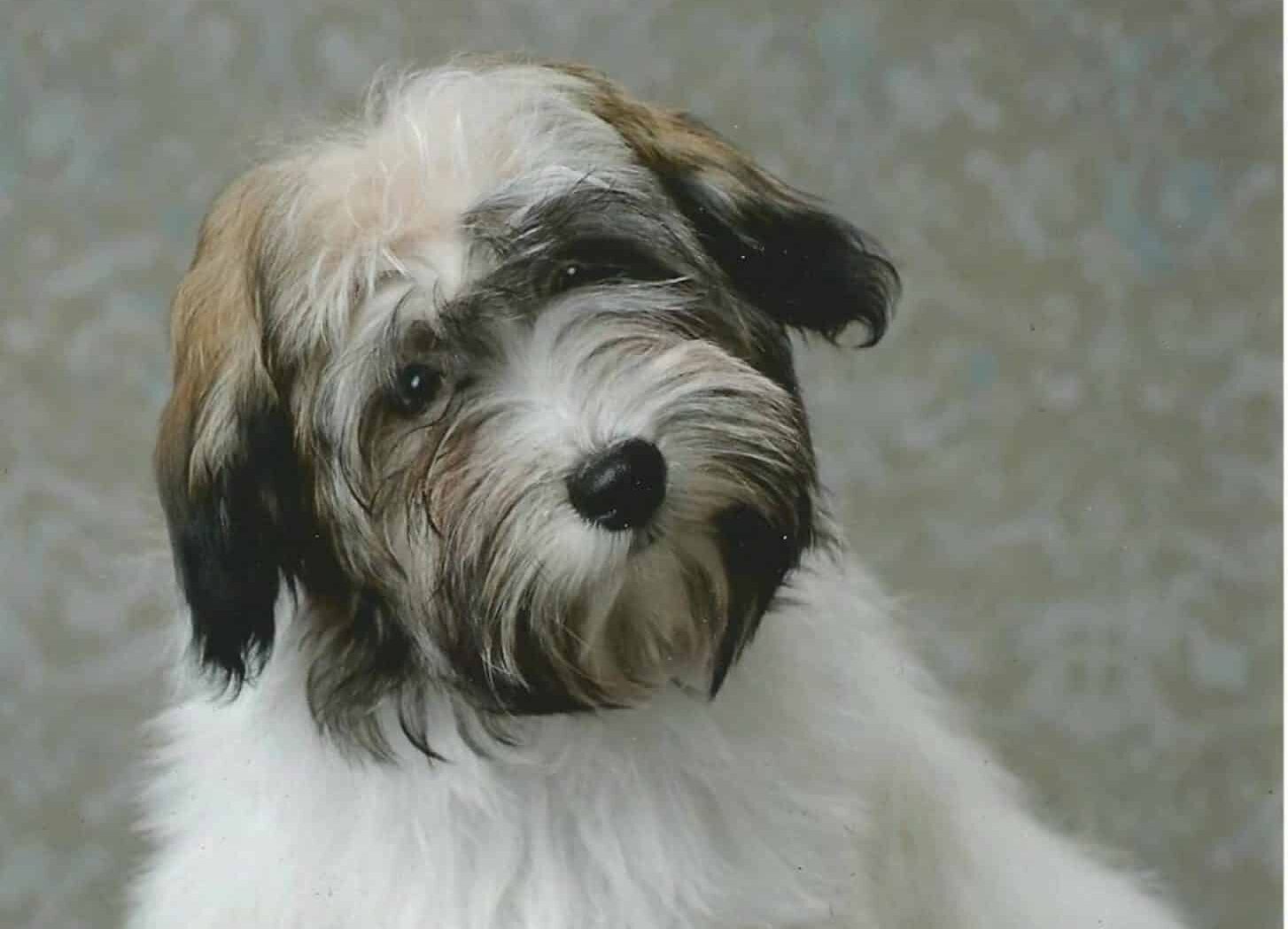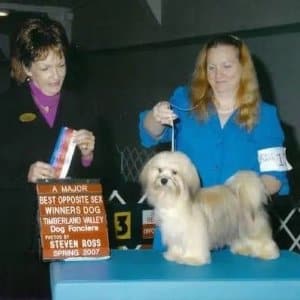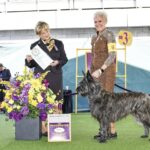The very first paragraph in the Havanese Standard says it all. It describes our wonderful breed in a nutshell. So, why is it so difficult to understand when you are actually in the process of evaluating a dog for show potential at home, or evaluating a class of dogs in the show ring?
GENERAL APPEARANCE:
The Havanese is a small, sturdy dog of immense charm. The native dog of Cuba, he is beloved as a friendly, intelligent, and playful companion. He is slightly longer than tall, with a long, untrimmed, double coat. The Havanese has a short upper arm with moderate shoulder layback and a straight topline that rises slightly from the withers to the croup. The plumed tail is carried arched forward, up over the back. The unique, springy gait is a result of the breed’s structure and playful, spirited personality. These characteristics of temperament, coat, structure, and gait are essential to type.
The Havanese is a small, sturdy dog of immense charm. Well—your version of small and mine may be two different ideas. But the standard goes on to say, the Havanese must not be under 8.5 inches or over 11.5 inches at the withers. As a judge, you can wicket if you are unsure. As a breeder, you should know before you take your dog into the ring if it is within the standard. So, if your idea of small does not include an 11.5 inch tall dog, then you are not understanding the AKC standard. The Havanese breeders who approved this standard are telling you, point blank, small is anything between 8.5 and 11.5 inches, and we go on to say that our preferred height is 9 to 10.5 inches. Easy enough, right? Not really, because the standard goes on to describe the length of body in relation to height, and the amount of bone we want our dogs to have; all to help you understand what is meant by small. The standard uses the word “slightly”—the Havanese should be slightly longer than tall, with a rectangular outline. The standard even goes on to describe the rectangle. The length should come from the rib cage, not the loin. The loin is short! When I evaluate puppies, I want my length to be 2/3 from sternum to last rib and 1/3 from last rib to buttock. If you think a dog looks too long, put your finger on the last rib. Stand back. Does it divide the dog directly in half? Then chances are, your eye is right, the dog is longer than we are describing as slightly longer in the standard. (Could also be that the dog looks long because it is actually low on leg, creating an optical illusion). So, now you understand what the standard means by slightly longer than tall and a rectangle.
So, what else makes up a small, sturdy Havanese? Bone. The standard calls for moderate bone. The Havanese should never appear coarse or fragile. The Havanese that is 8.5 inches is going to be smaller than the Havanese that is 11.5 inches, but both should have sturdy, moderate bone. That 8.5 inch Havanese should not be fine-boned and the 11.5 inch Havanese should not be heavy-boned. Remember, this breed is meant to be a family companion for all ages. I would never want to have to tell a family with small children that my puppies are too fragile for their family! My ideal is approximately 1.25 to 1.5 pounds per inch tall. So, as an example, an 8.5 inch Havanese should be about 10 pounds to as much as 12 pounds. An 11.5 inch Havanese could be 14 to 17 pounds and still be considered small and sturdy. You, as breeders, can breed to your preference for size, and judges, if all else is equal, can also have a preference for size. You cannot award a dog that is under- or over-sized, fragile or coarse. Always keep in mind that the HCA preference is 9-10.5 inches. You cannot award a poor quality, small Havanese over a good quality, larger Havanese just because you prefer small and feel the breed should be small to be in the Toy Group. And yes, I have seen it happen.
So, let’s move on next to “Immense Charm.” What does this mean and how do you judge it in the show ring? How does the exhibitor show his/her dog’s immense charm? That is easy! It is described under temperament in the standard! Friendly, playful, alert and intelligent, sweet and non-quarrelsome. Aggression and shyness should be faulted. So, why are we seeing aggressive Havanese in the ring? Why are they being awarded ribbons? The standard says it should be faulted. Now, luckily, we see less aggressive Havanese than shy Havanese. The standard also says that shyness should be faulted. And yet, I see Havanese with their tails between their legs, crouching away from judges on the table, simply scared to death, being awarded winning ribbons. I am not telling you do not show it; they need to learn that shows are fun, and with some youngsters it may take awhile. But I personally do not care how wonderful your dog is at home; if it is aggressive or shy in the ring, it should never take home a winning ribbon. And no owner, handler or breeder should ever expect one. Just consider it an expensive
handling class.
The first paragraph of the standard goes on to talk about the coat; long, untrimmed, double coat. There seems to be a huge division of thought on what is correct when discussing the coat. First of all, age will determine the length of coat. A coat of shorter length on a younger dog should not be faulted. Even some adults that have a slower growing coat may have shorter length. But, it should always be a double coat on an adult Havanese and should never be trimmed! The standard describes the perfect coat: Silky to the touch, soft and light in texture. The outercoat carries slightly more weight. It stands off the body, flows with movement, and is abundant and wavy. Dogs can be shown corded as well. Puppy coats can be softer than adults, and they also may not have much undercoat development. If the coat is flat, frizzy or curly, it should be faulted. If it is coarse or wiry it is a DQ. The standard is pretty explicit on how the coat should be and goes on to say that head furnishings can be in simple braids; simple, plain bands holding the braids in place. The big issue is what can be done to the coat to comply with the sentence that states: “Natural as is consistent with good grooming.” I think it is simply stated in the standard and should be adhered to. Minimal trimming of the anal and genital area is allowed, but should not be seen on presentation. Hair on the feet and between the pads should be trimmed. No other trimming or sculpting of the coat is permitted. It is to be severely penalized as to preclude placement. For some reason, time after time, I see obviously scissored coats being rewarded and, yes, many are also flat ironed. Why? The standard calls for a wavy coat! Flat ironing also changes the texture of the coat. It is no longer that soft, wavy, lightweight coat. When a standard says it should be severely penalized and preclude placement, why are they winning? Is the rest of the entry, untrimmed and being shown naturally (but brushed!) that bad that the judges cannot “see” the trimming of the coat and the excessive shaving around the bum? The HCA has stated in their standard that they do not want this level of grooming awarded.
Another area of confusion in the standard is the “part.” Most adult Havanese coats will fall down from the middle of their backs to the sides. If they do not, they have an incorrect coat. The coat should not stand off their backs like a Bichon. Remember, it is to be a long coat. Long coats will fall to either side. What the standard says, very clearly, is that the coat should not be deliberately parted. Meaning, not a Yorkie or Maltese part that is perfect and done with a knitting needle! And never should the dog’s coat be parted and held in place by hairspray! Yes, I have watched it being done right outside the ring. Judges, please understand that a correct coat is going to part. Time and again I have had handlers and owners tell me they were scolded in the ring for the dogs’ coat parting. And just where would those judges like the coats to fall? Even brushed straight back, the dog shakes and the coat falls to either side, naturally.
The first paragraph of Havanese Standard also describes the topline in the Havanese. For a while, when I first started showing Havanese, I saw dogs winning with excessive rises. Putting my hands on them, I realized it was either they had crooked front legs, poor shoulder assembly or no rear angulation… or they were a bad combination of all of that. But, they had a rise and so the judges were rewarding that. It seems that the breeders have gotten better about choosing keeper puppies with better front legs and somewhat better shoulders, and all should be looking for that short upper arm. But now, the toplines seem to have gone in completely the opposite direction. We now have level toplines. Finding a slight rise is getting harder and harder. I hear it all the time from judges. They are seeing it across the country. We are losing the short upper arm, the topline, and the springy gait. I see videos on Facebook, and maybe one in five has a slight rise on the move. The well-behaved puppy with a level topline wins because the judges can’t get past that cute face and happy temperament. Please remember, this is a hallmark of the breed and is what makes the Havanese outline different from other breeds. While I am glad that we have less and less chondrodysplastic dogs being shown and bred, I would hate to lose this hallmark of the breed. The plumed tail also adds to that beautiful correct outline. While I would not throw out a tight or loose tail, I would hope that breeders would choose mates, carefully, to try to breed away from those traits. We want to keep that arched tail; another hallmark of our breed.
The springy gait is also mentioned in the first paragraph of Havanese Standard. This is so important to distinguish a Havanese from a Shih Tzu or Lhasa. The structure and attitude both contribute to the gait. The Havanese should never be run around the ring. They are not a Sporting dog and should not have the reach and drive of one. They also should not have lift in the front like a Min Pin. And yes, I have seen both being rewarded. They are to be shown on a loose lead, but this does not mean the lead should be dragging on the ground behind the dog. The handler still has to have control over the dog. What is meant here is that the HCA does not want to see the Havanese being strung up as is so popular with other Toy dogs. Stringing them up, letting them run, or letting them sniff the ground all throw off the topline on the move. It is important to see the topline rise on the move, not just while stacked. So, no tight leads, but also not so loose that the dog is then controlling how they move around the ring instead of the handler controlling the dog. Yes, this is a training issue too, but keep in mind that these little dogs are happy and inquisitive, and letting them have too much leeway on that loose lead can lead to a disaster.
I hope that I have helped you understand the hallmarks of the breed. Keep in mind that these are simply my opinions and how I personally have interpreted the breed standard. If you want to know how I evaluate puppies and adult dogs, and how I determine overall balance and quality, I would be happy to discuss my thoughts with you. My email address is [email protected].
The Havanese Standard | What’s So Hard To Understand?










